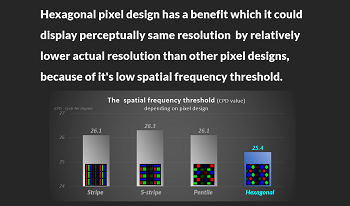
Pixel designs can be made in a variety of ways to produce full color. Designs using stripe, S-stripes, pentiles, and hexagons are frequently employed. In this study, we have conducted perceptual experiments to determine the spatial frequency (CPD) threshold of each pixel design. Based on the 4 kinds of pixel design, we created various stimuli. They are stripe line-patterns that are oriented in five distinct directions (angle: 0, 90, 45, 23, and 62degrees), each with a several CPD (cycle per degrees) and contrast ratio but a similar luminance (about 70 cd/m2). As a result, the spatial frequency threshold of the hexagonal shape is lower than that of other designs in all directions. This implies that hexagonal shapes with comparatively lesser resolution may provide equivalent perceived resolution to other designs. However, there is not big difference between each design. Therefore, more research and study on different patterns or stimuli (such as text, words or images utilized in daily life) are required in the future.
Dong-yeol Yeom, In-hye Heo, Yong-woo Yi, "Perceptual Experiment for Searching the Spatial Frequency Threshold Depending on Pixel Design" in Electronic Imaging, 2024, pp 234-1 - 234-3, https://doi.org/10.2352/EI.2024.36.11.HVEI-234
 Find this author on Google Scholar
Find this author on Google Scholar Find this author on PubMed
Find this author on PubMed